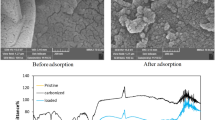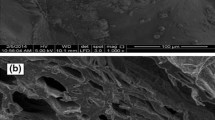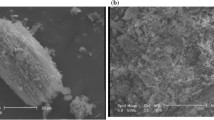Abstract
In the present study, the effect of adsorbent dose, pH, temperature, initial dye concentration and contact time on malachite green removal from an aqueous medium using hydrilla verticillata biomass has been investigated. The central composite face-centered experimental design (CFCD) in respons surface methodology (RSM) was used for designing the experiments as well as for full response surface estimation. The optimum conditions for maximum removal of malachite green from an aqueous solution of 75.52 mg/L were as follows: adsorbent dose (11.14 g/L), pH (8.4), temperature (48.4°C) and contact time (194.5 min). This was evidenced by the higher value of coefficient of determination (R 2= 0.9158).
Similar content being viewed by others
References
Mohamed M. Acid dye removal: comparison of surfactant-modified mesoporous FSM-16 with activated carbon derived from rice husk. Journal of Colloid and Interface Science, 2004, 272: 28–34
Ho S and Mckay G A. Comparison of chemisorption kinetic models applied to pollutant removal on various sorbents. Trans IChemE, 1998, 7: 123–129
Safarik I, Tackova L and Safarikova M. Adsorption of dyes on magnetically labeled baker’s yeast cells, European Cells and Materials, 2002, 3: 52–55
Chiou M S, Ho PY, Li H Y. Adsorption Behavior of Dye AAVN and RB4 in Acid Solutions on Chemically Cross-Linked Chitosan Beads. J Chin Inst Chem Engrs, 2003, 34: 625–634
Bunluesin S, Bruattrachue M, Prayadpokethitiyook. Batch and continuous packed column studies of cadmium biosorption by hydrilla verticillata biomass. Journal of bioscience and bioengineering, 2007, 103: 509–513
Low K S, Lee C K, Heng L L. Sorption of basic dyes by Hydrilla verticillata, Environmental Technology, 1994, 15: 115–124
Khattri S D, Singh MK. Colour removal from dye wastewater using sugar cane dust as an adsorbent, Adsorpt Sci Technol, 1999, 17: 269–282
Culp S J, Beland FA. Malachite green: a toxicological review, J Am College Toxicol, 1996, 15: 219–238
Culp S J, Blankenship L R, Kusewitt D F, Doerge D R. Toxicity and metabolism of malachite green and leucomalachite green during short-term feeding to Fischer 344 rats and B6C3F[1]mice, Chem Biol Interact, 1999, 122: 153–170
Alderman D J. Malachite green-a review, J Fish Dis, 1985, 8: 289–298
Sawa Y, Hoten M, Antibacterial activity of basic dyes on the dyed acrylic fibers, Sen I Gakkaishi, 2001, 57: 153–158
Clifton-Hadley R S, Alderman D J. The effects of malachite green upon proliferative kidney-disease, J. Fish Dis, 1987, 10: 101–107
McKay G, Otterburn M S, Aga D A. Fullers earth and fired clay as adsorbent for dye stuffs, equilibrium and rate constants, Water Air Soil Pollut, 1985, 24: 307–322
Gregory A R, Elliot S, Kluge P. Ames testing of direct black 3B parallel carcinogenecity, J Appl Toxicol, 1991, 1: 308–313
Srivastava S J, Singh N D, Srivastava A K, Sinha R. A cute toxicity of malachite green and its effects on certain blood parameters of a catfish, Heteropneustes Fossilis, Aquat Toxicol, 1995, 31: 241–247
Singh S, Das M, Khanna S K. Biodegradation of malachite green and rhodamine-B by cecal microflora of rats, Biochem Biophys Res Commun, 1994, 200: 1544–1550
Srivastava S, Sinha R, Roy D. Toxicological effects of malachite green, Aquat Toxicol, 2004, 66: 319–329
Elibol M, Ozer D. Response surface methodological approach for inclusion of perfluorocarbon in actinorhodin fermentation medium. Process Biochem, 2002, 38: 667–773
Umesh K, Garg Kaur M P, Garg Dhiraj Sud M V. Removal of nickel [II] from aqueous solution by adsorption on agricultural waste biomass using a response methodological approach. Bioresource Technology, 2008, 99: 1325–1331
Annadurai G, Juang R S, Lee D J. Adsorption of heavy metals from water using banana and orange peels. Water Sci Technol 2003, 47: 185–190
Gopal M, Pakshirajan K, Swaminathan T. Heavy metal removal by biosorption using Phanerochaete hrysosporium. Appl Biochem Biotechnol, 2002, 102: 227–237
Author information
Authors and Affiliations
Corresponding author
Rights and permissions
About this article
Cite this article
Rajeshkannan, R., Rajamohan, N. & Rajasimman, M. Removal of malachite green from aqueous solution by sorption on hydrilla verticillata biomass using response surface methodology. Front. Chem. Eng. China 3, 146–154 (2009). https://doi.org/10.1007/s11705-009-0007-x
Received:
Accepted:
Published:
Issue Date:
DOI: https://doi.org/10.1007/s11705-009-0007-x




